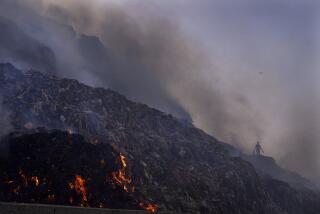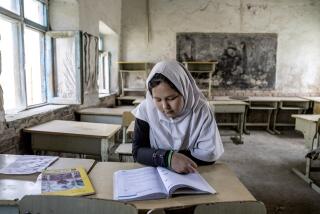Afghan opium crop soared this year, U.N. says

KABUL, Afghanistan — In a harsh indictment of the Western-funded drug eradication effort in Afghanistan, the United Nations on Wednesday reported an increase of nearly 50% in the 2013 opium harvest, with land used for cultivation reaching an all-time high.
The annual survey underscored the growing threat in the world’s largest opium-producing nation. The unchecked spread of opium cultivation has brought widespread corruption, political instability and enormous profits for the Taliban insurgency, which controls Afghanistan’s primary poppy-growing provinces.
The United Nations Office on Drugs and Crime called the survey results “sobering” and criticized multibillion-dollar drug eradication efforts by the international community. The “dangerous countrywide trend of escalation” should come as “a warning and an urgent call to action,” said Yury Fedotov, executive director of the office.
The 2013 harvest involved about 510,000 acres under production, the most since 2007, when the U.N. reported a then-record 478,000 acres. The average yield per acre in 2013 rose by 11% from last year.
The United States alone has spent more than $6 billion fighting opium in Afghanistan through faltering eradication programs and largely ineffective attempts to persuade farmers to instead raise legal crops such as wheat. The U.S.-led coalition abandoned early efforts by its combat forces to destroy opium crops for fear of driving farmers into the arms of the Taliban. Eradication is now left to the Afghan government.
Opium earns far more per acre than any other crop; 72% of farmers surveyed by the U.N. cited high prices for opium as their main reason for growing the crop, up from 44% in 2012.
The report says that only 7% of opium farmers surveyed who had ceased growing poppies said they did so out of fear of eradication efforts. The most common reason cited for stopping production was because it violates Islamic beliefs, followed by the Afghan government ban on growing opium.
The historic production increase may have been spurred, in part, by the planned withdrawal of NATO combat forces by the end of 2014, the report says. It notes that some farmers may have tried to “hedge against the country’s uncertain political future.”
Documentation of opium expansion comes at a critical political and security juncture. The United States and Afghanistan are negotiating a security agreement designed to define post-2014 arrangements. Afghan national elections are scheduled in April to choose a successor to President Hamid Karzai, whose relations with the U.S. have soured in recent years.
The U.S. Embassy in Kabul declined to immediately comment on the opium report.
The U.N. survey puts opium production in 2013 at 5,500 tons, a nearly 50% increase from 2012 and fueled in part by high prices last year. This year’s production surge in turn has led to a 12% decline in prices that, while possibly discouraging poppy planting next year, may make the drug more attractive this year to Afghanistan’s several million opium and heroin addicts.
Two Afghan provinces that had been declared opium-free began growing small amounts of poppies in 2013, raising the number of cultivation areas to 19 of Afghanistan’s 34 provinces.
The director of the Afghan government’s Counter Narcotics Police, Maj. Gen. Khalilullah Bakhtiyar, said he did not dispute the U.N. findings. But he emphasized that the bulk of production has come from areas not under government control, and said police have curbed poppy growing in regions dominated by the central government in Kabul.
“I’m sure everyone understands that insecurity provides grounds for poppy cultivation in some parts of the country,” Bakhtiyar said in a telephone interview. “We have some good plans for fighting narcotics this year as well as for the year ahead.”
He said police confiscated 14% of Afghanistan’s opium crop in 2013 and arrested more than 4,000 smugglers and dealers, including eight major international dealers. On Tuesday, the narcotics police in Kabul staged a mass burning of 21 tons of confiscated opium, other narcotics and alcohol.
The U.N. report says Afghan narcotics police have tripled their effectiveness in recent years, confiscating “well over 10%” of the country’s opium production. But it says the numbers of arrests, prosecutions and convictions of powerful figures in the drug trade remain low.
The report notes that opium cultivation in Kabul province, largely controlled by the government, rose by 148% this year from 2012, and no poppy crops were eradicated in the province this year. Production was negligible — 736 acres — compared with that in southern provinces, but it underscored the lack of eradication efforts in the government’s backyard.
Just two southern provinces, Helmand and Kandahar, accounted for 62% of Afghanistan’s 2013 opium production. Both provinces are dominated by the Taliban.
Despite localized security gains by international and Afghan government forces in the two provinces, only about 5,200 acres of opium in Helmand and 2,700 acres in Kandahar were eradicated. Production this year rose 34% in Helmand and 16% in Kandahar.
“If the drug problem is not taken more seriously by aid, development and security actors,” the U.N. report says, “the virus of opium will further reduce the resistance of its host, already suffering from dangerously low immune levels due to fragmentation, conflict, patronage, corruption and impunity.”
Special correspondent Hashmat Baktash contributed to this report.
More to Read
Start your day right
Sign up for Essential California for news, features and recommendations from the L.A. Times and beyond in your inbox six days a week.
You may occasionally receive promotional content from the Los Angeles Times.







